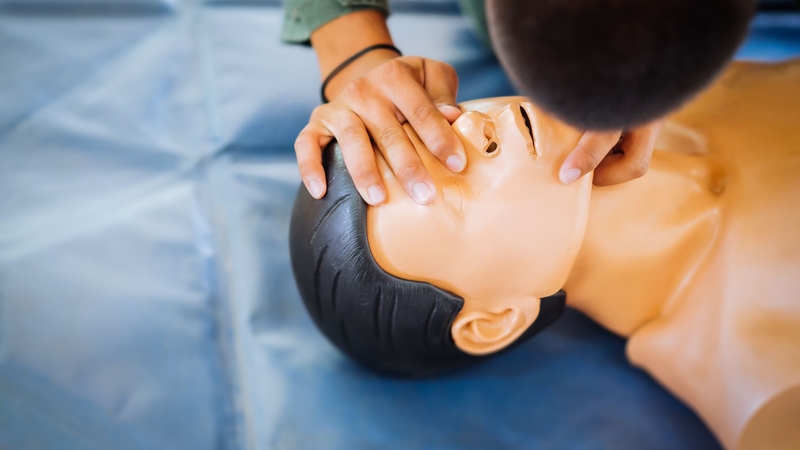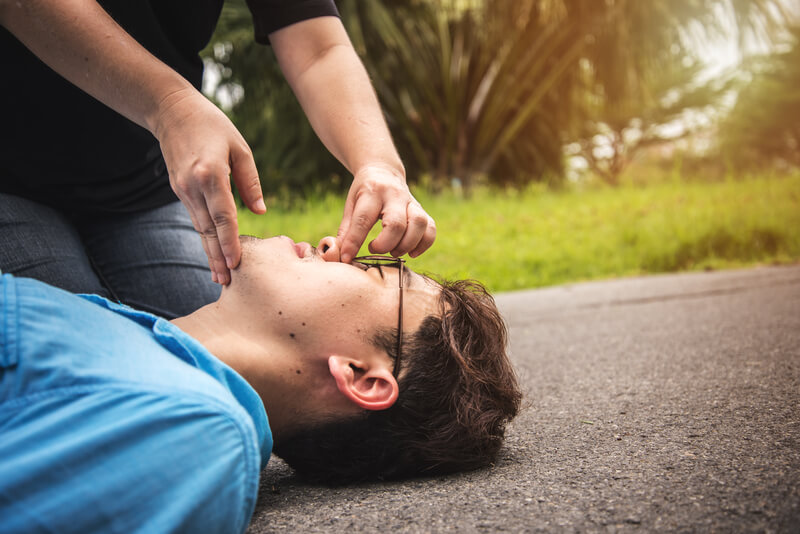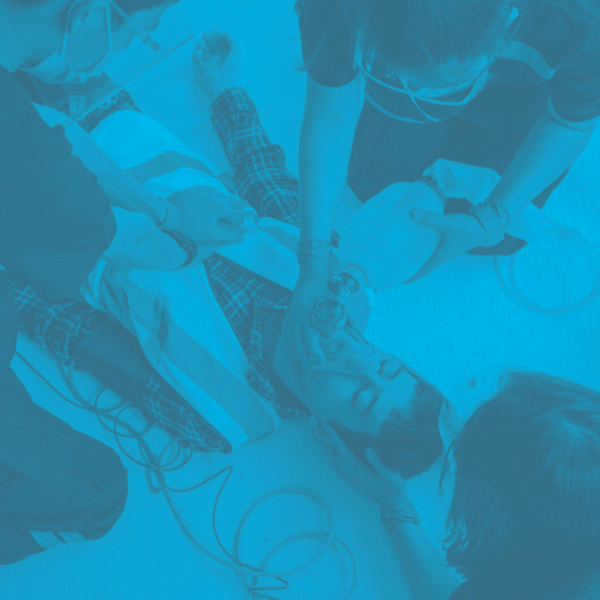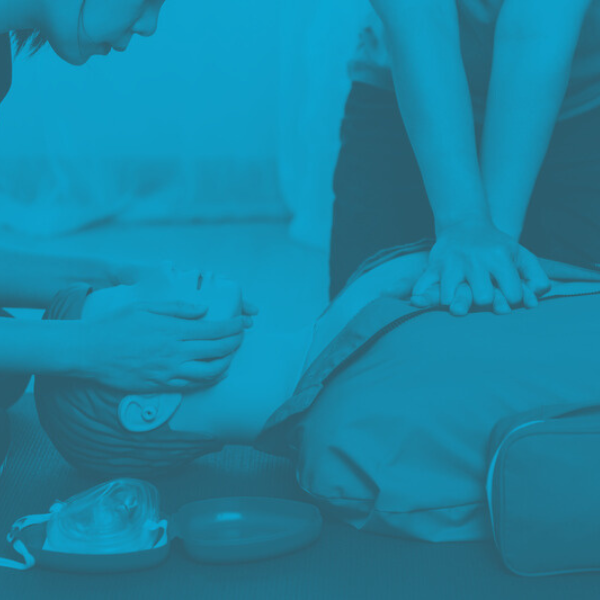How to Perform a Head Tilt Chin Lift Maneuver? A Step-by-Step Guide
How to Perform a Head Tilt Chin Lift Maneuver? A Step-by-Step Guide

by Greta Kviklyte
Life Saver, AMC
Co-authored by Kim Murray, RN, M.S.
posted on Jan 31, 2025, at 5:00 am
In emergency medical situations it is critical to effectively manage a patient’s airway and ensure it remains unobstructed. Patients need to be treated quickly to reduce the risk of suffocation, brain damage, and other serious complications.
One of the fundamental techniques used by first responders and other healthcare providers in these instances is the head tilt chin lift maneuver. This simple but vital procedure can save lives by opening a patient’s airway.
Here is what you need to know about this procedure’s importance, step-by-step implementation, indications and contraindications, associated risks, and role in emergency care scenarios.
We offer Online CPR and BLS Certification
A Tilted Head Opens the Airway
An airway obstruction can happen when a person’s tongue or other soft tissues block airflow into the lungs. In an unconscious person, the muscles relax more fully than they would in someone awake or even deeply asleep. This heightened level of relaxation and diminished muscle tone causes the tongue to fall back and obstruct the airway.
Naturally, this is an issue that needs immediate correction to prevent a host of different problems that can have significant, long-term consequences. The head tilt chin lift position counteracts airway obstruction and makes it easier for medical professionals to get air into a person’s lungs. Seconds count, so the goal is to use the fastest and most accurate procedure based on the unconscious person’s needs.
The Importance of the Head Tilt Chin Lift Maneuver
While there are other ways to handle airway management in an unresponsive patient, the head tilt chin lift position is considered the gold standard. It helps clear the airway by:
- Moving the tongue away from the back of the throat
- Allowing for effective ventilation during rescue breathing
- Aligning the oral and pharyngeal axes
When giving breaths to an adult use the head-tilt/chin-lift technique to open the airway unless there is a specific reason you cannot (such as a spinal injury). Unlike options that use more complex airway devices, there is no specialized equipment required for this technique. It can be learned and used by medical professionals and laypersons without additional medical training.
When to Use the Head Tilt Chin Lift Position
 There are several scenarios where this procedure is the best choice. These include:
There are several scenarios where this procedure is the best choice. These include:
- Unconscious patients without suspected spinal injuries
- Basic Life Support (BLS) and Cardiopulmonary resuscitation Life Support (CPR)
- Cardiac arrest situations where an airway needs established
- Patients experiencing airway obstruction due to tongue relaxation
These are the main situations where a properly tilted head can create an airway. However, there are also times when this procedure either will not be effective or could cause harm. It is essential to know when not to use the head tilt chin lift maneuver.
When to Avoid the Head Tilt Chin Lift
While the head tilt chin lift is a highly effective way of opening an airway in an unconscious patient, there is another method of opening the airway with a suspected neck injury. If you have any suspicion that the patient may have a spinal injury, choose the jaw thrust maneuver vs head tilt-chin lift.
This reduces the risk of exacerbating potential cervical spine injuries and creates an adequate airway for treatment. Any time there is the potential for a neck injury it is important to err on the side of caution. For patients without spinal injuries, though, the head tilt chin lift is the preferred airway management method.
Step-by-Step Procedure for the Head Tilt Chin Lift
Now that you know when to use this maneuver (and when not to), what steps should you follow to open the airway? How do you know if you are performing the maneuver correctly? While this is not a complicated procedure to perform, doing it correctly is important due to the vital nature of creating and maintaining an airway in an unconscious patient.
Here are clear, step-by-step instructions for everything you need to do.
Step 1: Get in the Right Position
To get into the proper position for this maneuver, you will want to either kneel beside the patient or position yourself near their head. You need to be able to easily reach their head and chin to have access to the area you need to adjust for airway management.
Step 2: Pay Close Attention to Hand Placement
Use one hand to put pressure on the patient’s forehead. With the other hand, place your fingers under the bony part of the chin. Once your hands are properly placed you can perform the maneuver safely and effectively.
Step 3: Tilt the Head While Lifting the Chin
Gently push down on the forehead while lifting the chin upward at the same time. This will move the tongue away from the back of the throat, so the airway stays open.
When giving breaths to an adult use the head-tilt/chin-lift technique neutral, or the head-tilt/chin-lift technique past neutral. In other words, you can tilt the head into a neutral position, but may also need to go past neutral to fully open the airway. For infants and very young children, you should stay in the neutral position, as going past neutral can restrict their airways.
Step 4: Check for Proper Alignment
The patient’s mouth should be slightly open. Their head should be in a neutral or slightly past neutral position to give them maximum airflow. You can adjust the head position between neutral and past neutral as needed, to ensure the patient is breathing as easily as possible.
Step 5: Check for Proper Breathing
There are several ways to check for breathing in an unconscious patient including observing chest movements, listening for breath sounds, and leaning in close to the patient to feel for breath on your cheek.
Step 6: Provide Rescue Breathing if Needed
If a patient is not breathing on their own you should begin rescue breathing or proceed with CPR as the situation requires. The specifics of the patient and their needs will affect the additional measures taken.
Practical Tips for Effective Care
Airway management is essential when an unconscious person has an airway obstruction and cannot breathe clearly on their own. However, the head tilt chin lift is not without risk. To minimize the chances of causing injury during this procedure, there are some practical tips to follow. These include:
- Using minimal force to avoid causing jaw or neck injuries.
- Avoiding excessive backward tilting of the head, which can actually compromise the airway instead of opening it.
- Monitoring the patient continuously to ensure the airway remains clear.
During stressful situations, adequate training can help reduce injury risk and make the right treatment options more instinctual. The goal is to act quickly and with skill in order to maximize a patient’s chances of survival and lower the chances of significant or long-term injury.
The Role in Cardiopulmonary Resuscitation
Using the head tilt chin lift position is critical during CPR. First, it helps to establish a patient airway during the initial assessment of an unresponsive patient. Second, it is part of the “airway” component of the “ABC” sequence (Airway, Breathing, Circulation). Lastly, when combined with rescue breaths it ensures that the patient will receive oxygen until advanced airway management is available.
Risks and Complications
The head tilt chin lift is generally considered safe for most people. However, there are some risks to consider. Understanding how the procedure could cause harm is the first step in reducing the chances of injuring a patient while establishing an airway. The primary risks of this maneuver are:
- Neck injury through improper technique or too much force.
- Jaw or facial pain through excessive force and soft tissue injury.
- Inadequate airway clearance due to failure to maintain the correct position.
Fortunately, these risks and avoidable with practice and the proper technique. Knowing how much force to apply and when to consider the jaw thrust maneuver vs head tilt-chin lift are critical components of successfully treating an unconscious patient with an airway obstruction.
Comparing the Jaw Thrust Maneuver vs Head Tilt-Chin Lift
 Understanding the main differences between the head tilt chin lift and jaw thrust maneuver is vital to knowing when to use each one. The goal is to be as effective as possible while reducing the risk of harm, and knowing is a powerful way to do that.
Understanding the main differences between the head tilt chin lift and jaw thrust maneuver is vital to knowing when to use each one. The goal is to be as effective as possible while reducing the risk of harm, and knowing is a powerful way to do that.
Use the head tilt chin lift for non-traumatic airway management. It is simple and widely used but is potentially unsafe for spinal injury patients. If your patient has a suspected spinal injury, choose the jaw thrust maneuver. While this method of maintaining an airway requires more skill, it is the procedure of choice for suspected cervical spine injuries.
Practice and Train to Increase Safety and Effectiveness
Mastering life-saving procedures like maintaining an airway in an unconscious patient requires regular training and practice. The right course and certification programs go a long way toward learning everything you need to know. That can help you stay up-to-date on all the best ways to help and protect patients and give you confidence in your abilities when you need to use these techniques.
Online courses are an option to begin training or to renew or add to your certifications as a medical professional. These courses can also help laypersons learn first aid, CPR, and other essential skills for emergencies. For most online courses you can expect to:
- Review the online materials for your certification.
- Watch the skills videos to understand the procedures and techniques discussed.
- Take (and pass) an exam to provide proof of your certification.
While there are still some types of classes and certifications that need to be done in person, online training can significantly enhance the knowledge and skills needed in medical settings. You can also practice with others in a hands-on environment to ensure you are comfortable with specifics such as hand placement and the right amount of tilt to maximize the airway opening.
The Head Tilt Chin Lift Maneuver Is a Life-Saving Technique
This procedure is a cornerstone of basic airway management because it is simple, effective, and accessible to nearly everyone. That makes it a critical part of emergency care and a way to save lives. Whether it is performed by a healthcare professional or a layperson who responds to an unconscious person, knowing how to do this maneuver safely can make the difference between life and death for a person needing help to breathe.
This crucial skill is one that every medical professional should have, and staying aware of any updates to the technique or its use cases helps reduce risk and improves the chances for patients who need this type of care. With regular training, an understanding of when to use this method and when to avoid it, and a focus on the proper technique it is possible to maximize the life-saving potential of this position.
Frequently Asked Questions
Can the head tilt-chin lift procedure be used on infants?
Yes, this procedure can be used on infants, toddlers, and young children. However, taking additional care and a gentler approach is very important when helping babies and children. They are more flexible and delicate than an adult, and that makes it possible for them to be injured during the maneuver. The best way to reduce the risk of injury is to make sure to tilt their head back only slightly since an excessive tilt can obstruct their airway instead of opening it.
What should I do if I suspect a spinal injury?
If you suspect that a patient has a spinal injury it is best to choose the jaw thrust maneuver vs head tilt-chin lift technique to maintain the airway while minimizing spinal movement. While it is vital to open an airway for any patient with an obstruction in that area, you also want to lower the risk of causing or contributing to the risk of paralysis or other serious spine health problems.
How do I know if the airway is open after performing the head tilt chin lift?
After performing this maneuver you will want to observe the patient’s chest for movement, listen for their breath sounds, or feel for air movement on your cheek by leaning in close to them. If the patient is not breathing, rescue breaths should be given. You may also need to start CPR, depending on the patient’s condition and the presence of vital signs.
Take the first step in saving lives. Enroll in our BLS or CPR certification courses to gain the skills you need for emergencies. Start your journey with Advanced Medical Certification today!



